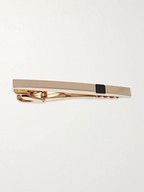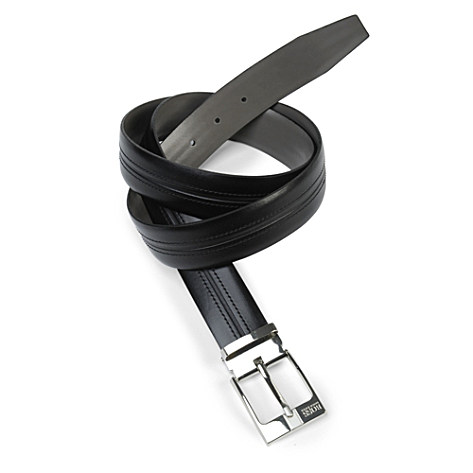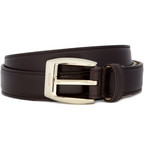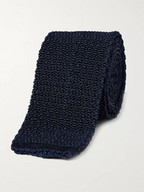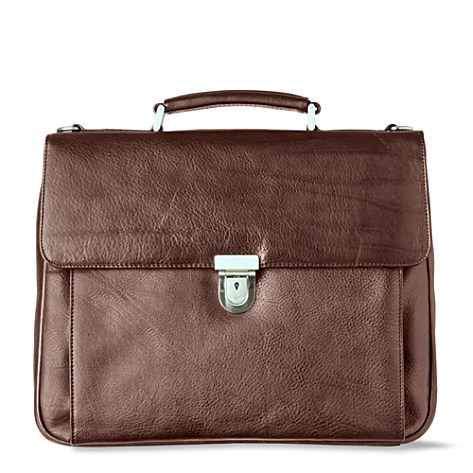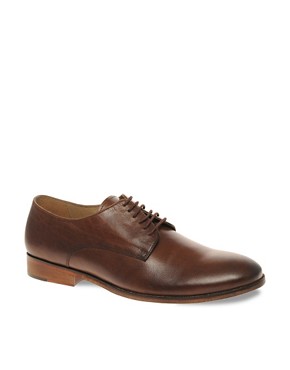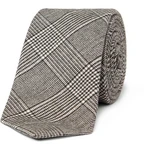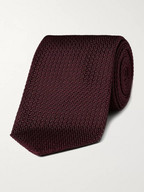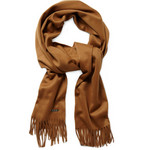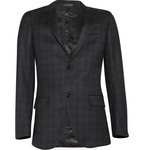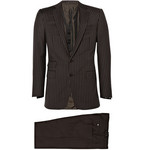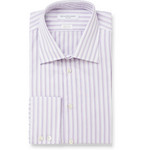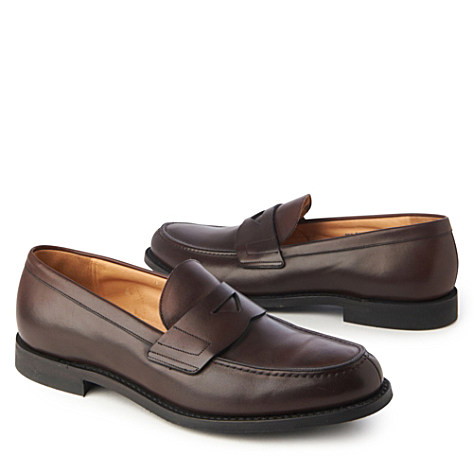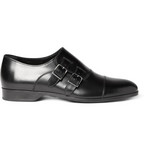Introduction
Unfortunately I will not be rousing your zest for fashion forward ideas with something original or innovative, but going back to basics can be the fulcrum for something inspirational, even when least expected. The motives for this article lay in the conundrum of looking just as good at school or work, as you do on the weekend. Some of the working people reading will not have such a dress code, but that does not mean they are any less restricted in their attire than the rest of us.
The suit, as much a dress-code as a sophisticated gentleman’s choice of attire, had origins in battle, which ties in perfectly with today’s military trend, before the lounge suit was at the heart of a fashion revolution in the 1800s. In this article, I will be writing about the origins of the lounge suit, and how best to wear attire that speaks volumes of the man donning it, before a word is spoken.
History Of The Suit
Recently at FashionBeans we have gone on a whistle stop tour of clothes and designs that have sculpted fashion and style in Britain. We have been proud proponents of all that is
classic and heritage, encouraging all of you to
add a dimension to your wardrobe that goes much further than just being cost-effective.The suit can be traced all the way back to the 17th century, where supreme King of England Charles II ruled with domineering grace and style. He promoted the idea of authority being impressed onto the public through a code of dress in the courts. As the suit went from in, to out of fashion – and back again – until the Edwardian era, the lounge suit established itself on the streets in the early 1900s. By this time, Savile Row was gaining a reputation that had seen royalty, and then the military, return time and again for fresh takes on the formal suit.
In the 1920s, tailoring started to become more apparent as wide-legged trousers were on trend, with the younger generation at the time sporting ‘oxford bags’. Trousers tended to be cuffed – a style that
Ralph Lauren Purple Label have certainly brought back into fashion – whilst only more senior members of society sported a double breasted jacket. Further changes in vogue were present in this decade until 1940, with high-waisted trousers being a common look. After cloth rationing began to subside post the Second World War, excess cloth was used and created a far boxier affect on the suit jacket in the 1950s to 60s. However, the real pioneers of remarkable tailoring are the Italians, who around the same time
set the precedent for flawless fitting suits, which unfortunately for our magnificent tailors, have only started taking advantage of recently.
At the heart of tailoring is allusion. Manipulation of the eye is brought about by important details being out of sync with the person’s body. What sets the modern suit apart from one that was considered stuffy and overly formal is the cut. Slimmer lapels, a nipped in waist line and less engulfing trousers was a look born on the streets of Naples and Rome in the middle of the 20th century. A lighter fabric meant less structure to the suit, giving a more relaxed outlook.
On the flip side, as the Victorian suit broadened the shoulders and covered up most of the body, almost shielding it from view, the traditional English suit contradicts the playful attitude of the Italian’s. That attitude really caught on here in the 1960s, where the rebellious mod culture that was so prominent at the time captured the essence of the Italian lifestyle. They enjoyed the coffee, the scooters and of course, the tailoring.
Look Book #1
How To Wear The Suit
The Fit
The key to achieving the understated elegance that resonates from a quality suit is the fit. I will briefly take you through four crucial steps to make sure you are looking as sharp as possible.
- An error exercised far too often these days lies at the feet of the man – pun intended. As the trouser leg falls,there is meant to be only one break at the front, and none at the back. A slim trouser leg needs to finish just above the shoe, so as to avoid it sitting on top of the laces.
- Another unforgivable error is the basic fit across the shoulders, where the sleeve should fall on the tip of the shoulder bone for a contemporary cut. Too much shoulder on show will have the adverse affect of making you look out of proportion, as your top half looks broad and your sleeve falls short of your wrist. Not a good look.
- Sleeve length is again of imperative importance so as to avoid the ‘hand-me down’ look. The common outlook is that the sleeve should finish between nine and eleven centimetres above the knuckle of the thumb, eleven centimetres only appropriate if you’re particularly proud of your cufflinks.
- Finally the length of the jacket is what defines the suit jacket and separates from its longer counterpart the sports jacket. It should finish no longer than mid-way down your backside, and no shorter than the top of your backside – too cropped and the jacket loses its masculinity.
Gordan Richardson at Topman feels there is a disparity between fashionable tailoring and the suit that you would wear to work, which he believes Topman has managed to breach. Topman advocate the more modern cut to great effect, as wearing a slimmer fitted jacket and trousers to work means you can look powerful and fashionable at the same time. With a good quality garment comes the option to tailor the pieces, so even if you have a good quality classic fitting jacket at home, a good tailor can move the arm hole higher and slim the arm at the very least to give your jacket a fresher, more modern look.
Ideally, a bespoke suit is the best suit. The outlay is by no means small, but if you are able to take advantage of the prestigious Savile Row tailoring, it is a must. The opportunities you will find are almost innumerable: flaps, lapels, breast pockets, hips pockets, trouser pockets, shoulder pads, cropped finish, double breasted… all of these options can influence your appearance. Looking taller, shorter, thinner or broader are all viable options when visiting a skilled craftsman like a tailor.
For further information about what to look out for when purchasing a suit, check out these articles:
The Details
Detail is what really separates the sartorial gent, from his try-hard offspring. Pocket squares have become an accessory that shows no sign of going anywhere; adding flair and some life to otherwise bland work wear. A timeless white cotton pocket square is simple but effective, whilst patterned, contrasting or complimentary coloured varieties really give the appearance that you know what you are doing in the style stakes.
Other accessories the stylish gent could use to complete the suited and booted look include the tie bar or pin. Shown off wonderfully on the impeccably attired men of the Mad Men series, they add an executive class to your formal dress, whilst also being practical.
If your suit fits correctly, then you should never have any need for a belt. However, slim classic leather belts can finish off a suit beautifully and take your overall appearance up a notch.
Finally, any well dressed man knows the power of a great watch. They can really make a statement and finish off your outfit perfectly; essentially they are a huge insight into your personality. Do you prefer gold, silver or leather straps? Do you opt for luxury brands or simply designer names? Do you prefer chunky designs or slim and streamlined?
All of you will have your own opinions on wearing a watch, but I would encourage you to invest wisely first time around. If you really want to show you care about the details and are a man of taste, then look no further than the true Swiss luxury brands. A watch is an investment piece that can last you a lifetime, so spend as much as you can comfortably afford. Remember that it could even end up as an heirloom within your family and passed down generations.
Personally, I would opt for a classic, fuss free design with a slim profile. You want your watch to fit seamlessly under your shirt and blazer, without creating any unnecessary bulk. Not only that, but slim designs are classy and show a refined elegance – perfect for the well dressed gentleman.
Just because you are looking toward luxury brands, it doesn’t mean you have to spend multiple thousands on your time piece. Watch makers like Tissot and Raymond Weil offer luxury craftsmanship and Swiss design at prices around the £500 mark. You can even pick up second hand bargains on places like
eBay and in vintage stores around the country. For those of you lucky enough to be able to really invest, why not try some of the major players such as Breitling, Tag, Rolex, IWC, Maurice Lacroix, Baume & Mercier and the like? It is up to you to pick a brand
that reflects who you are– whether that be through design, craftsmanship or even the company ethos.
Finally, an option for the modern male who really wants to stand out. We have had a real fascination with the world of vintage and revamping older pieces recently within men’s fashion, so why not try a pocket watch? Once the signature piece of royalty and the aristocracy, a pocket watch would definitely set you apart from the crowd these days. Shown in the look book below, the chain can be subtly placed in order to create intrigue, with them looking particularly good with a true 3 piece suit. Dandyism at its finest.
Suits Look Book
Example Outfits
Look One
This pairs the classic navy suit with coordinating colours which bring out the best of it. Browns will always look great when paired against navy, as it teases out the richness of the colour. A leather briefcase and a pair of classic Derbies are great options here with this classic take on tailoring. A pale blue shirt will coordinate well with the navy tone of the suit, whilst providing enough contrast against the navy tie in order to make it stand out.
The finishing touch which takes this outfit up a notch comes from the patterned red pocket square. This becomes the focal point of the whole outfit and due to it being a
contrasting colour, it will look superb against the blue backdrop. Just
don’t try and be too cute with it, this pattern will look so much better stuffed in, rather than folded neatly.
Look Two
Taking inspiration from two of this years key trends –
plaid and double breasted – we have
created a powerful office look that is still very professional. The double breasted suit is pin striped which hits the
sixties trend, as well as providing you with a real executive look. Keep the rest of the outfit stripped back and simple – a white shirt, black shoes and a small black holdall will anchor the look, allowing the suit to do all the talking.
Key touches that show some sartorial flair come in the details. A white pocket square is a perfect finishing touch that is understated but shows personality. A plaid/tartan inspired tie is on trend, but this muted piece means that you don’t look over the top or try hard. Finally, we opted for monk strap shoes in order to show that we know about the latest footwear trends, whilst also creating some separation from the rest of the work force.
Look Three
For those of you who can get away with bolder colours at work, this is an easy to put together look that will definitely have you standing out from the crowd. Here the fudge brown (similar to camel tone) suit is a statement on its own, especially when the rest of the population tend to stick to navy, black, grey or dark brown. The richness of the suit is bound to garner attention, meaning that you don’t actually have to dress it up too much.
Here we just anchor it with a white shirt, but finish it off with a tie in this season’s biggest colour trend, orange. The brown and orange will coordinate beautifully together, whilst I guarantee you that you will not see many people rocking an orange tie this year – it is too hard to pull off for the general population.
Look Four
Finally, we are taking another classic suit style that every man should have in their wardrobe. The grey suit is a very versatile piece that gives off a slightly more relaxed aesthetic when compared to its black or navy counterparts. This time we are going to introduce colour through our accessories and finishing touches, so we will again anchor the whole look with a classic white shirt. You could of course choose another anchoring colour such as black or even a different shade of grey if you wish.
We inject some colour with the tie and cashmere scarf. The burgundy colour tone is perfect for autumn/winter, and contrasts perfectly against the grey tone of the suit and the neutral white of the shirt. The camel coloured scarf is another on trend autumn/winter hue that not only coordinates with the grey, but the burgundy tie as well. Simply drape the scarf around your neck and tuck into your blazer for effortless elegance.
A tie pin will keep you looking pristine whether you are running for the train on the morning commute or wining and dining clients at a business lunch.
Conclusion
A well cut suit is one of the most important pieces in a man’s wardrobe. It has a long and distinguished history, and is your every day suit of armour in which to face the world. However, that doesn’t mean you have to become a stereotype; choosing the correct fit, getting your pieces professionally altered, and picking the right finishing accessoriesis what is going to make you stand out. Remember that life is too short to blend in, we need to make a statement of intent each and every day – so chose your suit carefully, stick your chest out and let the jeans and v-neck brigade melt as you waltz on impossibly dapper.
Next week we will have a detailed guide showing you how to dress down the suit, so be sure to check the back for tips on how to look unashamedly swanky when teaming a t-shirt and blazer.
Current Season Suiting






